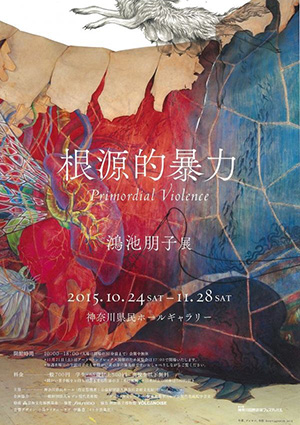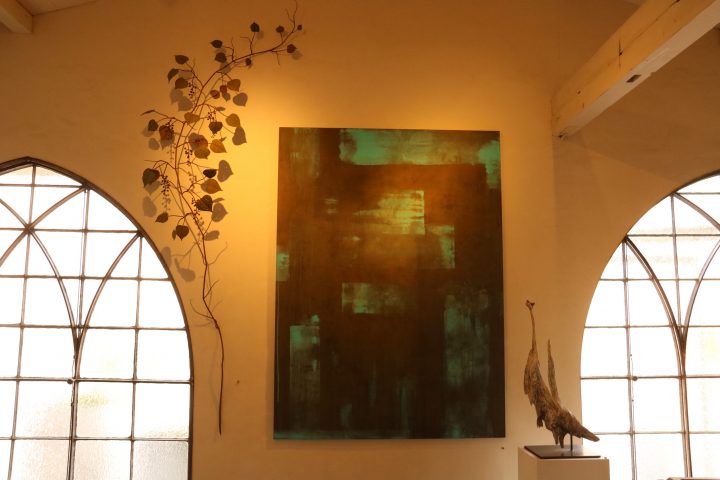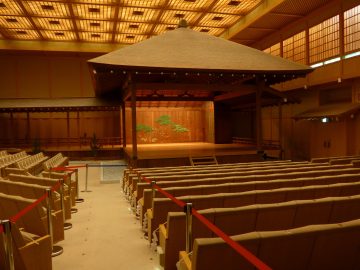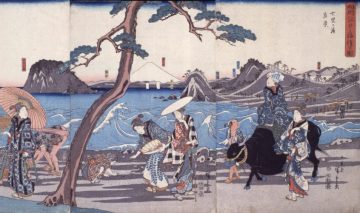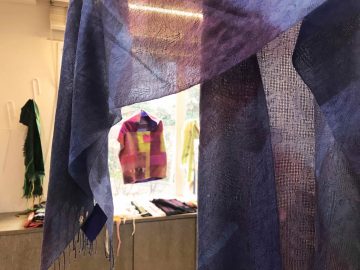Interview with Tomoko Konoike | I want a body that can accept the past and move forward
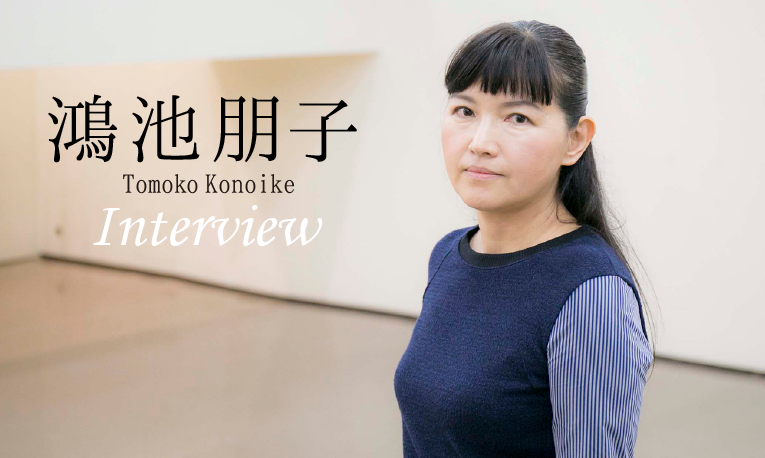
Interview & Text: Shinichi Uchida Photo (Portrait): Masamasa Nishino
Tomoko Konoike has used a variety of techniques to spin out expressions that seem to travel between fantastical other worlds. Is a big change happening to her now? Her first solo exhibition in the Tokyo metropolitan area in six years, "Primitive Violence," at the Kanagawa Prefectural Gallery, will be a place to experience that change firsthand. What has changed over time since her culmination exhibition, "Intertraveler: People Who Play with Myths," in 2009, and what remains the same? We asked her about her project in Tohoku, which was like a journey outside of art, and her current position, which she arrived at after a period when she "had nothing inside of herself."
Discomfort with the author's "control"
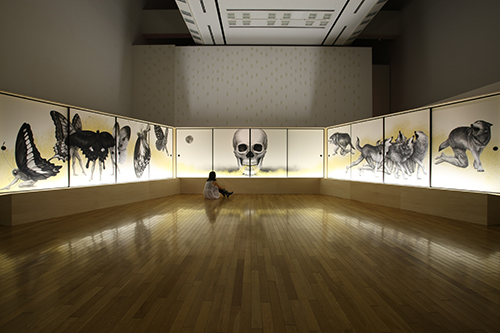
"Those who play with the Inter-Traveler Myth"《Shira Valley People, Wild People》/2009 /©Tomoko Konoike
--Mr. Koike has used a variety of techniques, including painting, sculpture, and animation, to create a world that could be described as mythical. However, from the advance materials for his latest solo exhibition, it seems that there are some major changes from the past. For example, instead of using sliding doors or canvases as in the past, he now paints on sewn cowhide, and also creates pottery using clay. These have a somewhat primitive and wild charm.
Koike : Not everything changed at a certain point. But I feel that my big solo exhibition "Intertraveler: People Who Play with Myths" (Tokyo Opera City Art Gallery) in 2009 and the Great East Japan Earthquake in 2011 were big turning points. In the process of creating that solo exhibition, I had an experience where I became aware of an unexpected power within myself. It was like the artist's "control" to control a large exhibition, a strange feeling I had never experienced before.
--Isn't it natural for an artist to have some control over the relationship between the work and the audience in an exhibition?
Koike : Of course, it was a big solo exhibition, so it was clear that as an artist, I needed the power to put it all together. As a result, I feel that this improved the quality of the exhibition. However, when I realized that I was using that power, which I had been making as I liked, I felt a great sense of incongruity. At the same time as being afraid that I could use this power more if I wanted to, I also had a premonition that if I pursued it further in the future, it would end up being something boring. Anyway, I was glad to have encountered this feeling, including the discomfort, and I thought I would remember it without forgetting it.
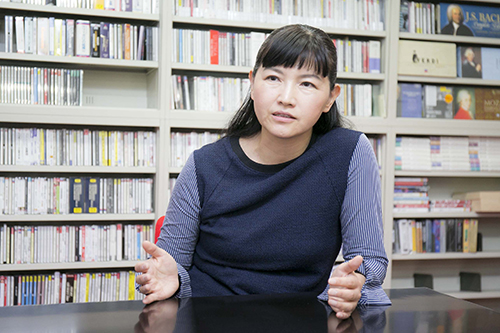
--Rather than simply growing or evolving as an artist, it seemed like this was a major turning point for you?
Koike : In the same year, the contrasting environment of my solo exhibition "Intertraveler 12 Poets" at Kirishima Open Air Museum gave me an opportunity to think further. I think the Opera City Art Gallery is a space in the city where you can immerse yourself in a philosophical experience through art appreciation. In contrast, Kirishima Open Air Museum is a site with a site of 13 hectares. The given environment is a space that includes a large forest and is not closed. I was confused about how to make use of this, and it was a pretty tough experience. While I was worried, I started to make my own route, like an animal trail, by stretching a rope outside (bitter smile). But in the end, I was left with something like a response.
--As you continued your work as an artist, were you able to re-evaluate art exhibitions, which had become a part of your everyday life?
Koike : I once again felt that an exhibition is something that is installed in a protected environment in many ways. However, many of the works are originally not suitable for exposure to sunlight, rain, and wind. Also, when an art exhibition opens, people involved often say "Congratulations!", and there are few people who criticize frankly. If you do not have the awareness that you are in such a "system" of art, it feels like you should look at it with parentheses, so to speak. However, even in such a hazy state, I continued to create works.
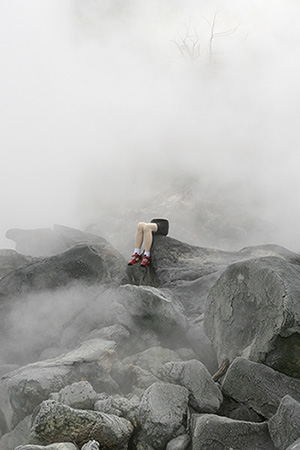
"Intertraveler 12 Poets" Exhibition / ©Tomoko Konoike
Away from the past
--What other changes did the Great East Japan Earthquake bring to you? After the disaster, you organized the "Mimio Library" project, which collected books from the public and delivered them to the disaster area along with the owners and stories about the books.
Koike : After the earthquake, I couldn't sit still and visited the disaster area, even though I couldn't do anything. I'm not sure if my initial actions led to anything good for the local area. However, through those experiences, I was able to clearly see the differences in thinking even among people close to me. This may be because my insight into such things naturally became sharper after the earthquake. In the midst of all this, I began to feel that something was wrong with continuing to live the exact same life as before.
--It seems that during this period you also moved your studio and left the gallery you had been contracted with.
Koike : Yes. I also wanted to do something far from Tokyo, so I started an experiment in Akita, where I was born. One of these projects, the "Myth of Opening Tohoku," was not for me to create my own works, but for local participants, who I consulted with one-on-one. At first, the local person who approached me wanted my solo exhibition, but I wanted to do something different. I had doubts about whether it was okay to always do and show the same structure, even though the climate and situation are different. It's not like I'm denying the existence of art museums.
--I heard that people of all professions and ages created works there.
Koike : Yes. Some of them liked painting, but there were also aunties who liked cooking and uncles who were good at carpentry. My mother, who is far from contemporary art, passionately talked about her ideas, saying, "I want to make a tower like this, and water will flow from the top...". However, none of them had thought about how to realize it, so I pulled it out and helped them out. What was born in this way may be difficult to evaluate on the general scale of art. But I was very surprised, delighted, and excited.
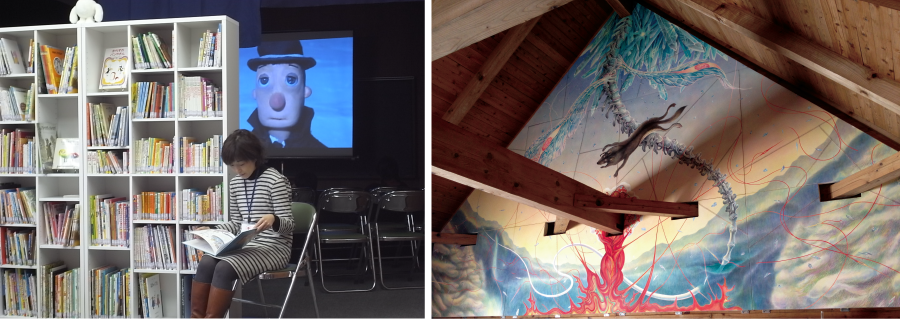
From left: Mimio Library Ishinomaki/Museum Lodge mural ©Tomoko Konoike
--So you're neither a creator who simply gives something, nor a passive observer.
Koike : So, receiving consultations from about 40 people was like touching the desires of the eight million gods as a single human being (laughs). At that time, there were a lot of things going on and I had nothing in me, so I could say that I actually learned new ways of making things from them. In addition, people who came to see the exhibition of the completed works started talking very lively. Everyone's hands and mouths moved so much that they were noisy, saying, "What is this?" (laughs). I feel like I received something wild that is different from the so-called interactive art experience.
--During that period you also had a solo exhibition in San Francisco and a large-scale public art installation at the Waterras complex in central Tokyo (both in 2013).
Koike : Yes. In those places, I felt that people expected me to be the "Tomoko Koike of the past," and I felt like I was responding to that. However, gradually, I felt suffocated by continuing only that. So, I felt like I was changing little by little. In Akita, we also did a project called "Museum Lodge." Although it was a museum, it was actually an attempt to bring works with friends to mountain huts in the mountains and install them. I approached it with an experimental feeling, wondering if it would be okay to get away from the idea of success and failure as a so-called art exhibition.
--Did these experiments eventually lead to you creating works using animal leather, clay, pottery, etc.?
Koike : At first, I started kneading clay when I couldn't do anything myself. I spent about six months or a year looking for something that would make my hands happy. My encounter with leather is similar. Leather is soft and cushiony to the touch, and lines form when you scratch it. The "feeling of scratching" also had a sculptural feel that you don't get from painting on paper.
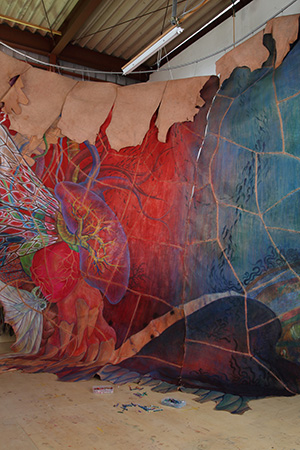
Work to be exhibited: Title Undecided / 2015 / Cowhide, crayon, watercolor / 600x2400cm / ©Tomoko Konoike
--It is also a part of a once living animal, and while it has a life force, I also feel that it is something to be feared when using.
Koike : When you paint it, it absorbs moisture, which is also like a living thing. Naturally, the feel is different on the front and back, and when you touch it when it is stretched out, it bounces, which is reminiscent of a baby's womb. Furthermore, the painting changes as it is exposed to the sun and deteriorates. In art, this is a negative element that is considered to deteriorate over time, but it also seems to reflect life as it is. I naturally felt that there was no shortage of opponents that I should face now.
--Alongside the materials, your approach to expression has also changed.
Koike : After the earthquake, I could no longer trust what I saw with my eyes, so the sense of touch became more important to me. It's like "seeing with your hands" and "touching and drawing". On the other hand, or maybe because of that, the pictures I draw there are very explanatory. There's a heart drawn here... or something like that. That's because the support on which I draw has a strong presence, and I feel like I'm putting makeup on it.
--Do you also feel liberated from the constraints of what painting should be?
Koike : I understand the Western style of painting, which is based on symbols and metaphors on canvas. However, I don't have the sense that painting is sublime, and I just paint my own pictures. My hands are not only used for creating works, but also for washing and cooking every day. The act of touching art materials is part of that life.
--This time, with the cooperation of the Akita Prefectural Museum, pottery from the Jomon period will also be included in the exhibits.
Koike : Ancient pottery is organized and considered in the field of natural history using specialized classification methods. However, when I heard from them that there are still things that cannot be seen by that alone, I thought, "I see." I thought that it was exactly the same in art. For example, if you arrange them not in the order in which they were created, but based on "good shape" or "good feel," something might happen. What will the audience feel at that time? I am also interested in such things now.
Beyond acknowledging the violence of "creation"
--What was the true meaning behind combining the word "violence" with "primitive" in the title of your solo exhibition?
Koike : "Making" means erecting some kind of stake that did not exist in the world before. This also applies to infrastructure necessary for modern life, such as buildings and roads. But the side on which the stake is erected, that is, nature, can be hurt. In a sense, it is unnatural against nature and becomes frictional resistance. You could call it violence, which means that there is an opponent. When I think about it that way, when I create something in this world, it always seems to arise in a relationship with something.

Works to be exhibited: "12 Hoyts" / 2015 / Cowhide, mixed media / ©Tomoko Konoike
--There is a similar violence in civilization and creative acts such as art. With that in mind, do you want to face the fundamental questions of why we create and what we create?
Koike : I myself have come to reconsider the meaning of showing what I do within the framework of art. However, buildings, books, cooking... everyone makes something every day. We humans have really created a lot of things up until now, but will that make us happy? There is always the question. I think that especially in the last few years, we have been reminded that there are things that we cannot control.
--Indeed, there are many events that make us reconsider the meaning of "creation," such as the earthquake disaster and reconstruction, the nuclear power plant issue, and more recently the large-scale construction plans surrounding the Tokyo Olympics.
Koike : I guess the people who see and view what has been created have also changed. And yet artists, including myself, have not changed... Maybe that's where the suffocation I've felt about myself comes from. To think about that, I'd like to get rid of things like self-expression and think about "making."
--So that's the thought behind the changes in your work.
Koike : The experience of being enchanted by a beautiful painting is also a wonderful thing. It makes you forget the "now", but I have no intention of denying it. If you deny it, you will end up being denied by something else. Instead, accept it and move forward. And I feel that it is different from sending out a message in a one-way manner by yourself. I would like to think about it with many people if possible.
--While I feel there are changes, I also feel there are things that have continued from the past. For example, the sense of going back and forth between this world and the "other world," and the world view that seems to be inhabited by a story.
Koike : That's right. But when my work is described as a "narrative painting," I wondered what that meant. While thinking about that myself, I attempted a project that allows you to see the creation of a story itself, called "Storytelling Table Runner." This is a project in which Akita's aunties tell their sad stories, important stories, and surprising stories, and draw them on a table runner (a cloth cloth that is hung on a part of the dining table). When you hear their stories from the sidelines, they seem like insignificant events, but I also felt the boldness and strength of the pre-modern era, which asks "What am I?"

--You may be on the "periphery" of the larger trends of the times, or in the world of art, but if you change your position a little, it seems like things would be different.
Koike : I think these stories are also the origin of "fairy tales". Oral stories that are not widely recorded in history, stories that will one day become anonymous... Although they all have a beginning, development, twist and conclusion, the ending is actually not that important. The famous story of "Little Red Riding Hood" also has many endings. I think the important thing is to meet something and come back. Sometimes magical events can completely change your position or situation, but similar things happen in reality too.
--I would like to ask you about Art Complex 2015 "Interworldly Marriage Story - We Can't Be the Same" which will be held in conjunction with your solo exhibition. Art Complex is a project that attempts new creations by combining contemporary art with other forms of expression such as dance and music. It has been held in conjunction with the contemporary art exhibition at Kanagawa Prefectural Hall.
Koike : This time, I will be using the space of a solo exhibition to work with Fuyuki Yamakawa, an artist and singer of khoomei (a throat song handed down in the Tuva Republic of the Russian Federation). I also asked Mayako Murai, a researcher of fairy tales and comparative literature, to supervise the exhibition.
--I'm looking forward to seeing how Yamakawa and Murai's activities will intersect with Konoike's interests from different angles.
Koike : The stage will be the "patterned hut" built in a large space in the middle of the exhibition. There, Yamakawa will become an object or a human, and it will be a performance in which he goes back and forth between "this side" and "that side". At that moment, it would be nice if we could create a hole in a different time axis, like a fairy tale. That may be quite different from what you think of as a "fairy tale". But now I want something that is not a definition of "this is what ○○ is" or a how-to explanation.
--It seems like you've moved quite a distance away from the place of "control" as an artist that you mentioned at the beginning.
Koike : That's right (laughs). I want to open it up rather than close it down. Even if it seems like it will get out of hand, I want to keep doing it.
--The title of this Art Complex includes the words "You can't stay the same." It's interesting to compare this with Mr. Koike's words, "It's important to go somewhere and come back." Will you continue to challenge yourself in the world of art and art exhibitions, even as you go through trial and error and change?
Koike : I feel like there are some parts of myself that don't seem to have changed, but on the other hand, it seems like everything may have changed. That's why my body reacted first. When the earth is shaking so unstably, it's only natural that things on it will change. I'm sure you all have some parts that are a bit awkward. But on the other hand, it may be that a force that doesn't arise when it's stable is born there.
--Do you think your latest solo exhibition will be a place where viewers can take in and think about the experiences that you have had today?
Koike : I intend to reflect what happened in my life in the exhibition in a relatively chronological order. From the mindset I just mentioned, I would like to create an exhibition that shows the "middle" of my journey, not the results or conclusions. I hope to think, worry, and play with the audience there. It's like, "I'm sure you too."
